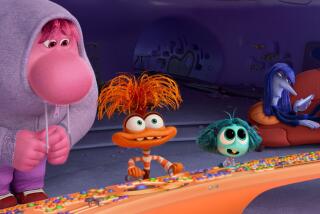A Psychological Approach to Rating Movies
- Share via
Parading by us is Jack Valenti and his Motion Picture Assn. of America rating change: NC-17 (Sept. 27). It’s time someone cried out, “The emperor is wearing no clothes!” Right now there seems to be an unconscious collusion between the MPAA and the parents its rating system is allegedly trying to inform. Children are the victims of that unwritten pact.
By continuing to patch up an obsolete muddle of categories (G, PG, PG-13, R, NC-17), the MPAA is pretending to communicate something and parents are pretending to understand that something. Neither gets the picture. The rating system is not
logical, not quantifiable and certainly not easy to utilize. By perpetrating this charade, the MPAA retains its power and parents remain blissfully ignorant, as they shirk responsibility to be more involved in their children’s viewing choices.
Another reason the MPAA lacks credibility is its overwhelming preoccupation with seeing sex as more threatening than violence. The latest change does not directly address this.
Only in our male-dominated society and entertainment industry would films be rated more harshly for sex, not violence. Men feel more uncomfortable about sex scenes than violent ones because sex scenes evoke men’s unconscious conflicts, including castration anxiety, homophobia, fears of inadequacy and impotence. Violent scenes, on the other hand, enhance men’s feelings of power. So whether one wants to attribute it to performance anxiety or testosterone, the male predilection for violence has been affecting the rating system for years.
If the movie industry wants to retain the privilege of self-regulation and stem the dangerous tide of censorship that is menacing any vestiges of creativity left in America, it needs to be more responsible.
Just as the regulation of air and water shouldn’t be turned over without ongoing scrutiny to industries that pollute these resources, similar scrutiny should be given to the entertainment industry, which affects an even more precious resource--our minds. Unfortunately, the creative freedom of all artists risks extinction because too many have greedily polluted viewers’ minds with psychologically destructive imagery. In this era of save the Earth, save the whales fervor, we must begin by saving our minds, and especially our children’s minds, from those who would exploit them for personal profit.
To address all of these problems, I propose the following new movie rating system, called MIND (Movies Influence Neuropsychological Development). It focuses on the psychological effects of imagery, simplifies the categories and removes the bias toward acceptance of violence over sex.
1. Movies should be rated in three categories: Child-Safe, Teen-Safe and Adult-Only.
2. Movies should be rated for the quality and quantity of their sexual content (S) and violent content (V), each on a scale of 0-10, with 10 the most psychologically harmful. Gratuitous acts of sex or violence would count more heavily than those necessary to the artistic integrity of the work.
3. In order to be categorized as Child-Safe, a movie would have to qualify as 0-2 in sexual and violent content ratings. Similarly, content would be rated 0-5 to qualify as Teen-Safe and 0-10 to qualify as Adult-Only.
4. Psychotherapists should make up at least 10% of the rating board to give expert opinion regarding psychologically damaging content.
5. To be rated, a movie would need a psychotherapist script consultant/technical adviser on staff to deal with psychological accuracy and suggest alternatives to psychologically damaging content.
Long ago, Freud discovered that our basic drives are sex and aggression. Today, the movie industry is capitalizing on them to hook audiences and sell popcorn. Now we need a rating system that acknowledges the extraordinary influence movies have on our minds.
See letters to Counterpunch, F4.
More to Read
Only good movies
Get the Indie Focus newsletter, Mark Olsen's weekly guide to the world of cinema.
You may occasionally receive promotional content from the Los Angeles Times.










